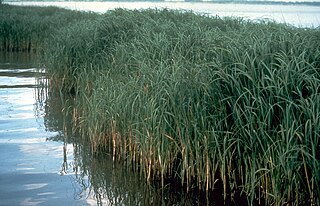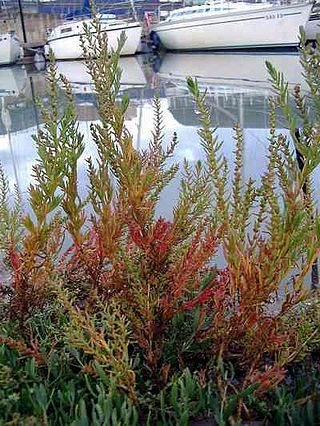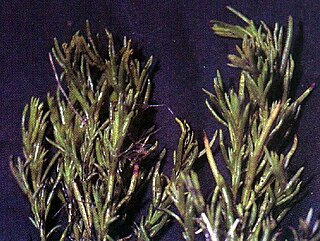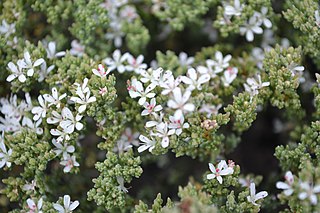
A halophyte is a salt-tolerant plant that grows in soil or waters of high salinity, coming into contact with saline water through its roots or by salt spray, such as in saline semi-deserts, mangrove swamps, marshes and sloughs, and seashores. The word derives from Ancient Greek ἅλας (halas) 'salt' and φυτόν (phyton) 'plant'. Halophytes have different anatomy, physiology and biochemistry than glycophytes. An example of a halophyte is the salt marsh grass Spartina alterniflora. Relatively few plant species are halophytes—perhaps only 2% of all plant species. Information about many of the earth's halophytes can be found in the ehaloph database.

The Tamaricaceae, the tamarisk family, are a family of plants native to drier areas of Europe, Asia, and Africa. It contains four genera: Tamarix, Reaumuria, Myricaria, and Myrtama.

The Eastern Desert is the part of the Sahara desert that is located east of the Nile river. It spans 223,000 square kilometres (86,000 sq mi) of northeastern Africa and is bordered by the Nile river to the west and the Red Sea and Gulf of Suez to the east. It extends through Egypt, Eritrea, Sudan and Ethiopia. The Eastern Desert is also known as the Red Sea Hills. The Eastern Desert consists of a mountain range which runs parallel to the coast, wide sedimentary plateaus extending from either side of the mountains and the Red Sea coast. The rainfall, climate, vegetation and animal life sustained in the desert varies between these different regions. The Eastern Desert has been a mining site for building materials, as well as precious and semi-precious metals, throughout history. It has historically contained many trade routes leading to and from the Red Sea, including the Suez Canal.

Avicennia marina, commonly known as grey mangrove or white mangrove, is a species of mangrove tree classified in the plant family Acanthaceae. As with other mangroves, it occurs in the intertidal zones of estuarine areas.

Suaeda is a genus of plants also known as seepweeds and sea-blites. Most species are confined to saline or alkaline soil habitats, such as coastal salt-flats and tidal wetlands. Many species have thick, succulent leaves, a characteristic seen in various plant genera that thrive in salty habitats.

Suaeda australis, the austral seablite, is a species of plant in the family Amaranthaceae, native to Australia. It grows to 10 to 90 cm in height, with a spreading habit and branching occurring from the base. The leaves are up to 40 mm in length and are succulent, linear and flattened. They are light green to purplish-red in colour.

Nitraria retusa, commonly known as Nitre bush, is a salt-tolerant and drought-resistant shrub in the family Nitrariaceae. It can grow to heights of 2.5 metres, although it seldom exceeds more than 1 m in height. It produces small white/green coloured flowers and small edible red fruit. The plant is native to desert areas of northern Africa, where it grows in primary succession on barren sand dunes, and in areas with high salinities such as salt marshes.

Suaeda calceoliformis is a species of flowering plant in the family Amaranthaceae known by several common names, including Pursh seepweed and horned seablite.

Suaeda nigra, often still known by the former name Suaeda moquinii, is a species of flowering plant in the amaranth family, known by the vernacular names bush seepweed or Mojave sea-blite.

Frankenia is the only genus in the Frankeniaceae family of flowering plants. Other genera have been recognized within the family, such as Anthobryum, Hypericopsis and Niederleinia, but molecular phylogenetic studies have consistently shown that they all belong inside Frankenia. Frankenia comprises about 70–80 species of shrubs, subshrubs and herbaceous plants, adapted to saline and dry environments throughout temperate and subtropical regions. A few species are in cultivation as ornamental plants.

Suaeda vera, also known as shrubby sea-blite, shrubby seablight or in the USA sometimes as alkali seepweed, is a species of flowering plant in the family Amaranthaceae. It is a small shrub, with very variable appearance over its wide range. It is a halophyte, and occurs in arid and semi-arid saltflats, salt marshes and similar habitats.

Suaeda maritima is a species of flowering plant in the family Amaranthaceae known by the common names herbaceous seepweed and annual seablite.

Salicornia europaea, known as marsh samphire, common glasswort or just glasswort, is a halophytic annual dicot flowering plant in the family Amaranthaceae. Glasswort is a succulent herb also known as ‘Pickle weed’ or ‘Marsh samphire’. As a succulent, it has high water content, which accounts for its slightly translucent look and gives it the descriptive name “glasswort.” To some people, it is known as “chicken toe” because of its shape. To others, it is called “saltwort.” It grows in various zones of intertidal salt marshes, on beaches, and among mangroves.

Suaeda aegyptiaca is a species of succulent plant in the family Amaranthaceae, and salt-tolerant (halophyte) plant that is distributed in eastern North Africa, the Near East and West Asia.
Suaeda fruticosa is a species of flowering plant in the family Amaranthaceae. It is a small shrub, with very variable appearance over its wide range. It is a halophyte, and occurs in arid and semi-arid saltflats, salt marshes and similar habitats.

Caroxylon vermiculatum, commonly known as Mediterranean saltwort, is a perennial plant in the family Amaranthaceae. It has many synonyms, including Salsola vermiculata and Nitrosalsola vermiculata. It is native to arid and semi-arid regions of the Middle East, North Africa and southern Europe where it is used as a fodder plant for livestock.
Juncus rigidus is a species of rush known by the common name sea rush. It is native to much of Africa and parts of western Asia. It is found inland and by the sea in sandy saline habitats.

Aeluropus lagopoides, sometimes called mangrove grass or rabbit-foot aeluropus, is a species of Eurasian and African plant in the grass family, found primarily in salty soils and waste places.
Suaeda monoica is a species of flowering plant in the sea-blite genus Suaeda, largely native to the shores of the Indian Ocean from South Africa to Sri Lanka, and salty areas inland. It has been introduced in Argentina. It exhibits phenotypic plasticity, with leaves that are much more succulent when grown under higher salinity conditions. Its leaves are edible, and it is used as an animal fodder plant where it grows.
Salsola melitensis is an endemic vascular plant of the Maltese archipelago. Its generic name is derived from the Latin word “salsus” which means salty, attributing to the salt tolerant nature of the species within this genus. The genus name was published in 1753 in the Species Plantarum composed by Carl Linnaeus but was reclassified again by Akhani et al. in 2007.
















